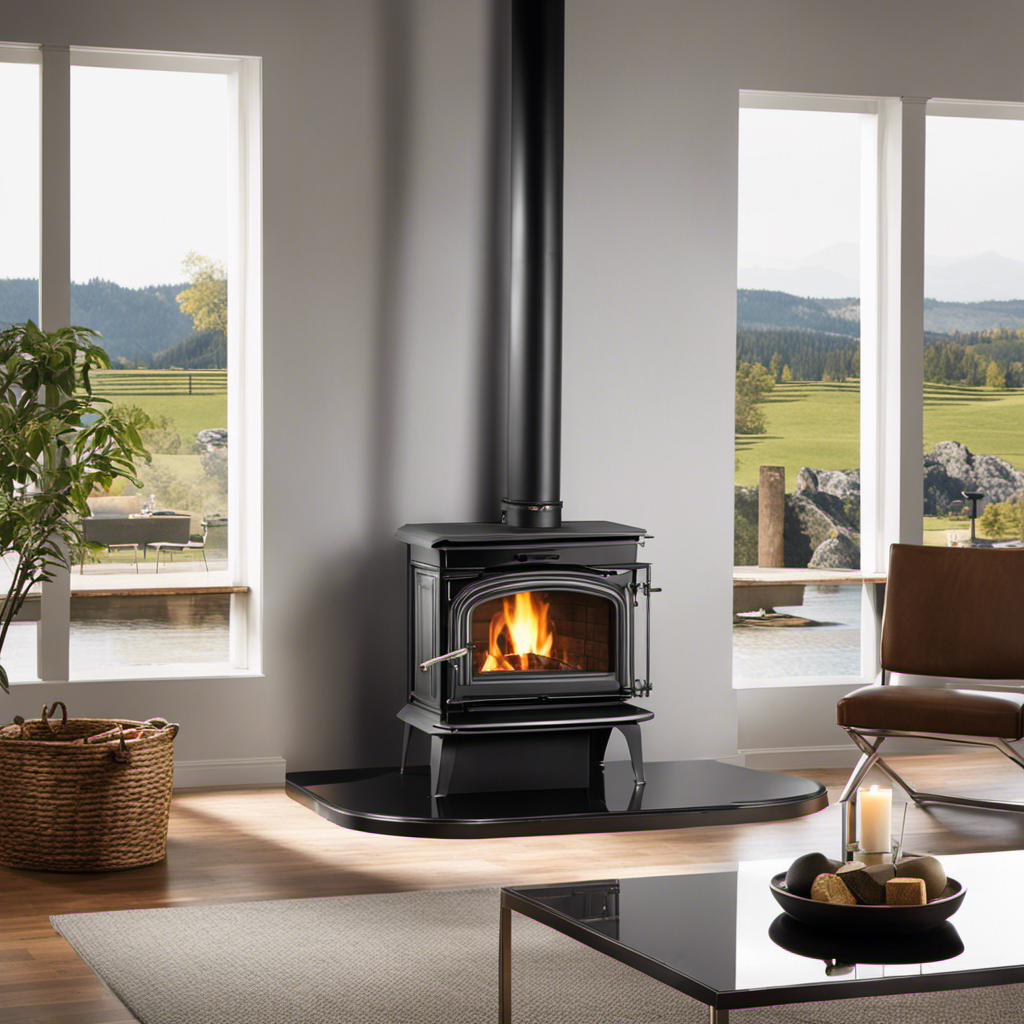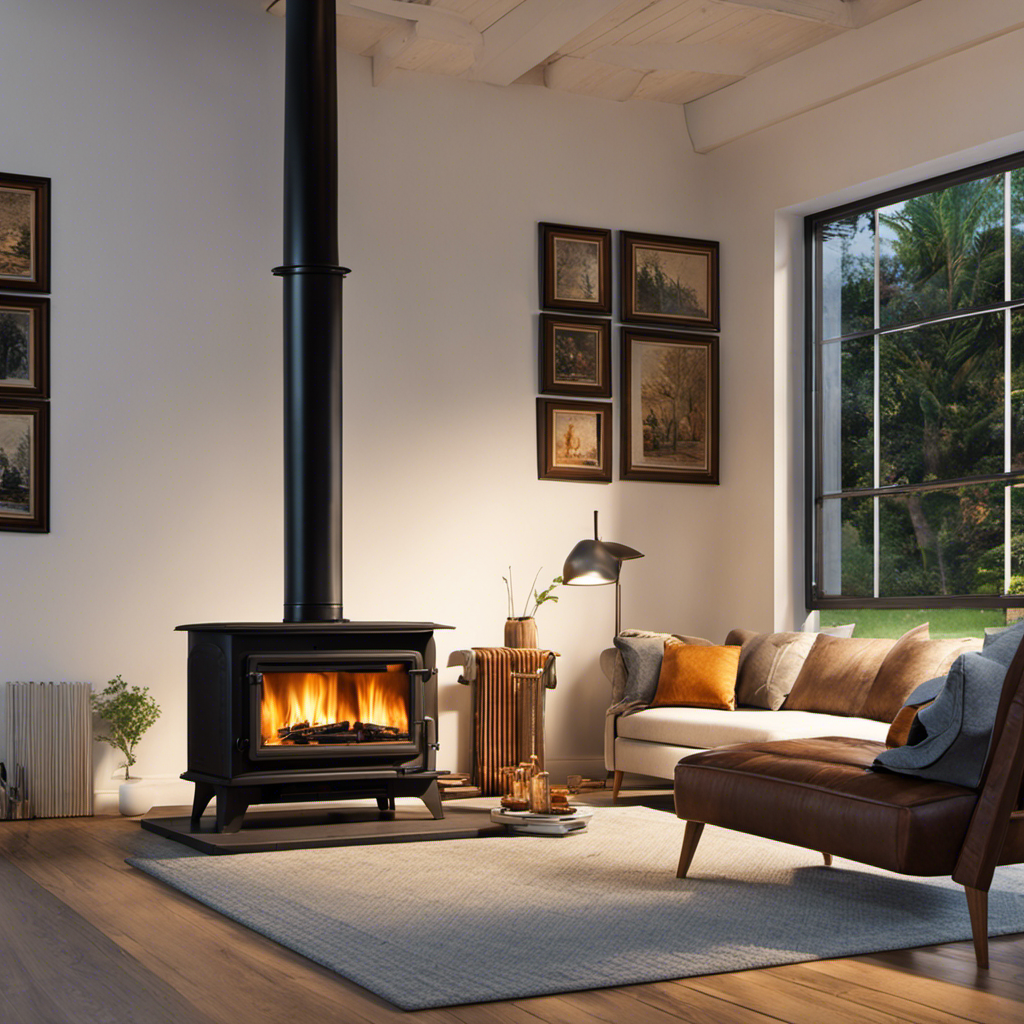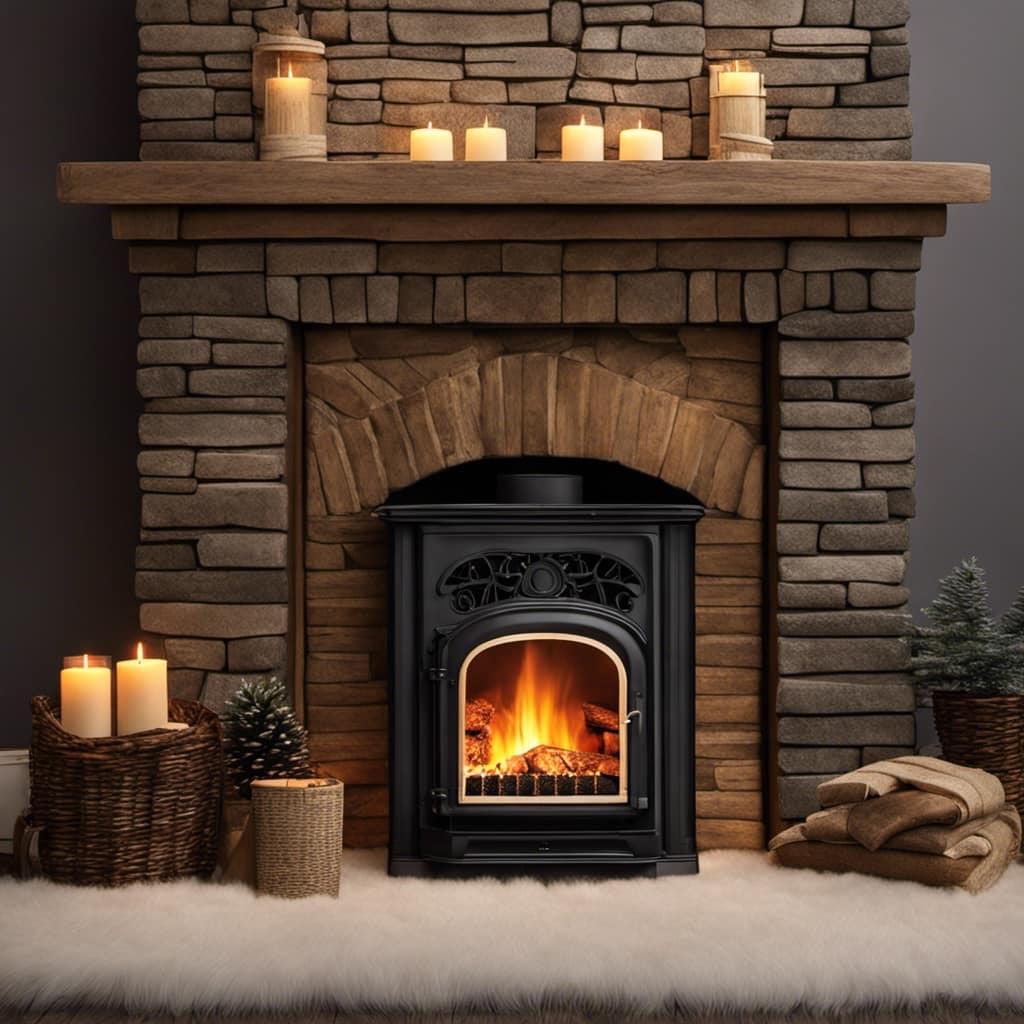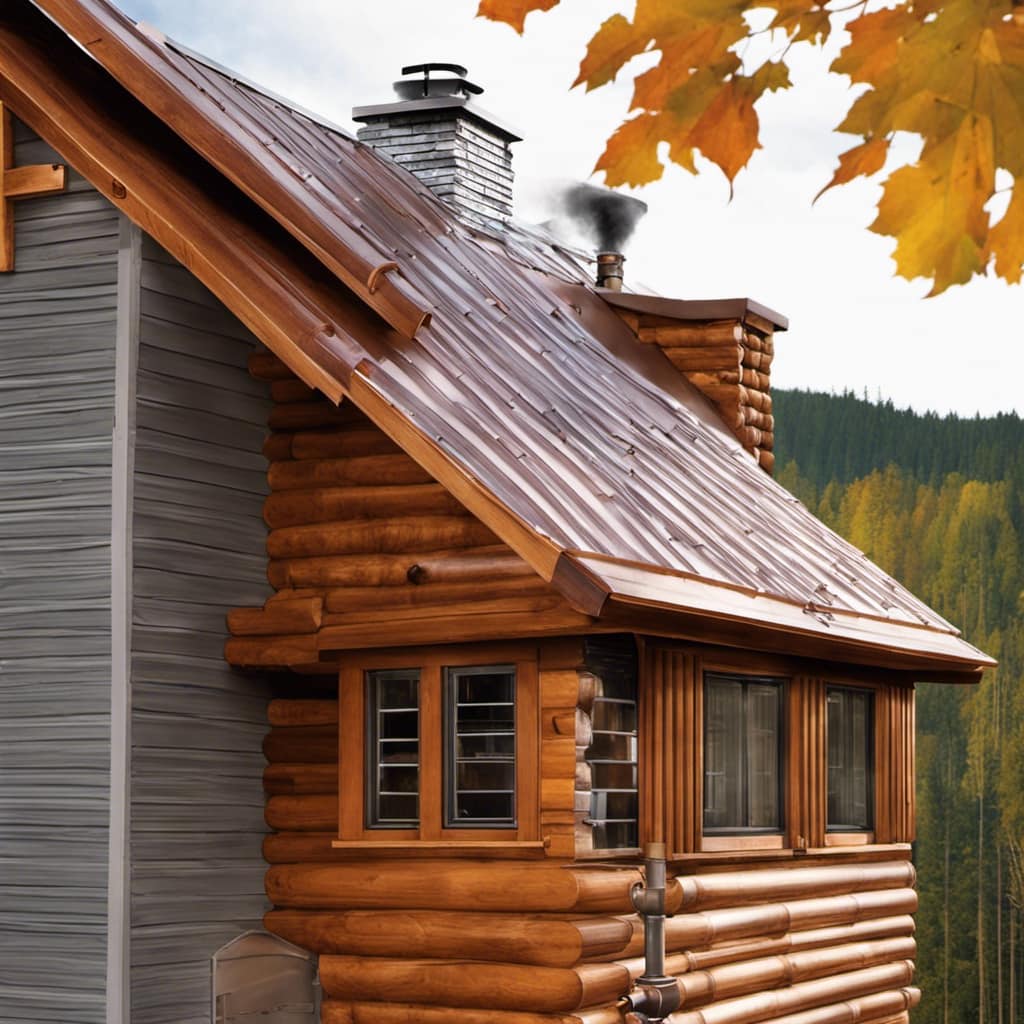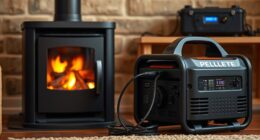The saying goes, ‘Where there’s smoke, there’s fire.’ When installing a wood stove to vent through a chimney, safety and proper functioning are crucial.
In this article, I’ll guide you through the steps of assessing compatibility, choosing the right venting system, preparing your fireplace, and installing the necessary components.
With my knowledgeable and detailed instructions, you’ll be able to enjoy the cozy warmth of your wood stove without any worries.
Key Takeaways
- Assess the dimensions and construction of the fireplace to determine if it can accommodate a wood stove.
- Choose the right venting system that complies with regulations and ensures proper draft and combustion.
- Prepare the fireplace by cleaning it thoroughly, checking the damper, and installing a chimney liner.
- Install the venting system securely, sealing joints and connections, and extending the chimney pipe through the roofline.
Assessing Your Fireplace and Wood Stove Compatibility
I need to assess if my fireplace and wood stove are compatible before making any changes.
Evaluating compatibility is crucial to ensure the safe and efficient operation of both the fireplace and the wood stove.
To begin the assessment, I’ll inspect the dimensions and construction of my fireplace and compare them to the specifications of the wood stove. It’s essential to determine if the fireplace can accommodate the size and weight of the wood stove.
Additionally, I’ll evaluate the condition of the chimney and flue system. Potential modifications may be required to ensure proper ventilation and to meet the safety standards.
Choosing the Right Venting System for Your Wood Stove
There are several factors to consider when choosing the right venting system for your wood stove, such as the size of the flue and the distance to combustible materials. It’s essential to select appropriate materials that comply with venting regulations to ensure safety and efficiency.
Here are three key points to consider:
-
Flue Size: The size of the flue should match the wood stove’s requirements to ensure proper draft and efficient combustion. A flue that’s too small can cause smoke to back up into the room, while a flue that’s too large can lead to poor draft and decreased efficiency.
-
Combustible Materials: The venting system should be installed at a safe distance from combustible materials, such as walls and ceilings. Following venting regulations is crucial to prevent the risk of fire and ensure compliance with local building codes.
-
Material Selection: Choosing the right materials for your venting system is essential. Stainless steel is a popular choice due to its durability and resistance to corrosion. Additionally, double-wall insulated pipes offer increased safety by reducing the risk of heat transfer to nearby combustible materials.
Preparing Your Fireplace for Wood Stove Venting
Before installing a wood stove, it is important to regularly clean and inspect your fireplace to ensure proper venting and safety. This involves choosing the right materials and measuring dimensions accurately. To help you understand the process, I have prepared a table that outlines the key steps involved in preparing your fireplace for wood stove venting.
| Step | Description |
|---|---|
| 1 | Clean the fireplace thoroughly, removing any debris or creosote buildup. |
| 2 | Check the condition of the fireplace damper and ensure it opens and closes properly. |
| 3 | Measure the dimensions of your fireplace opening to determine the size of the stove and venting system needed. |
| 4 | Install a chimney liner to improve draft and ensure proper venting of the wood stove. |
Installing the Venting System for Your Wood Stove
To properly vent your wood stove, you’ll need to install an insulated chimney pipe and a wall thimble. This ensures that the smoke and gases produced by the stove are safely expelled from your home.
Here are the steps to install the venting system for your wood stove:
-
Measure the distance from the stove to the ceiling, and from the ceiling to the roofline.
-
Choose the appropriate size and type of insulated chimney pipe for your stove.
-
Install the chimney pipe from the stove to the ceiling, ensuring a secure connection.
-
Use high-temperature silicone sealant to seal all joints and connections.
-
Install a wall thimble at the point where the chimney pipe passes through the wall.
-
Connect the chimney pipe to the thimble, again using high-temperature silicone sealant.
-
Extend the chimney pipe through the roofline and secure it with a chimney cap.
By following these steps and properly installing the venting pipes, you can ensure the safe and efficient operation of your wood stove.
Don’t forget to seal the fireplace opening to prevent any air leakage.
Ensuring Safety and Proper Operation of Your Wood Stove Venting System
I need to regularly inspect and clean my wood stove venting system to ensure its safety and proper operation. Venting system maintenance is crucial for the efficient functioning of a wood stove. Neglecting maintenance can lead to poor performance, increased risk of fire, and potential carbon monoxide poisoning. To ensure the safety and proper operation of my wood stove venting system, I follow a maintenance checklist that includes inspecting the chimney, cleaning the flue, and troubleshooting common venting issues.
Here is a table summarizing the steps involved in venting system maintenance:
| Maintenance Step | Description |
|---|---|
| Inspect Chimney | Examine the chimney for any cracks, blockages, or signs of wear and tear. Check that the cap and flashing are securely in place. |
| Clean Flue | Remove any creosote buildup from the flue using a chimney brush. Ensure there are no obstructions that could hinder proper airflow. |
| Troubleshoot | Address common venting issues such as backdrafting, excessive smoke, or poor draft. Check for leaks or gaps in the venting system. |
Frequently Asked Questions
How Do I Clean and Maintain the Venting System for My Wood Stove?
I clean and maintain my wood stove venting system regularly. It’s important to ensure proper airflow and prevent buildup. I troubleshoot any issues by checking for blockages, cleaning the chimney, and inspecting the flue pipe for cracks or damage.
Can I Use a Wood Stove Insert Instead of a Freestanding Wood Stove for Venting Through the Fireplace?
Yes, you can use a wood stove insert instead of a freestanding wood stove for venting through the fireplace. The installation process for a wood stove insert is similar to a freestanding wood stove. Some benefits of a wood stove insert include increased efficiency and heat output.
What Are the Potential Risks or Hazards of Venting a Wood Stove Through the Fireplace?
Potential risks and hazards of venting a wood stove through the fireplace include inadequate ventilation, increased risk of chimney fires, and improper venting techniques. It’s crucial to prioritize ventilation safety and ensure proper installation for optimal performance.
Are There Any Specific Building Codes or Regulations I Need to Follow When Venting a Wood Stove Through the Fireplace?
When venting a wood stove through the fireplace, it is essential to adhere to building codes and regulations. Proper venting system maintenance is crucial to prevent potential risks and hazards. Consider the advantages of a wood stove insert versus a freestanding stove, while also considering the aesthetic purposes of using the fireplace.
Can I Still Use My Fireplace for Aesthetic Purposes After Installing a Wood Stove Venting System?
Yes, you can still use your fireplace for aesthetic purposes after installing a wood stove venting system. The venting system allows for safe operation of the wood stove while maintaining the functionality of the fireplace.
Conclusion
In the journey of venting a wood stove through the fireplace, we’ve delved into assessing compatibility, choosing the right system, preparing the fireplace, and installing the venting system.
Just like a skilled craftsman carefully constructs each piece, we must ensure the safety and proper operation of our wood stove venting system.
Only then can we truly appreciate the warmth and beauty that our wood stove brings, as it dances with the flames to create a cozy sanctuary within our homes.

